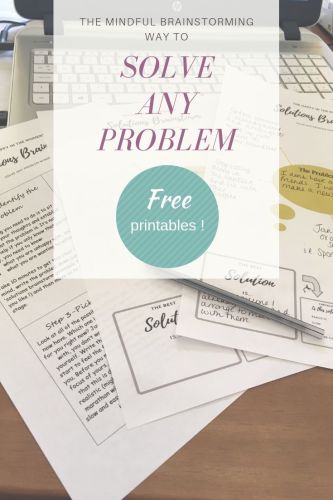Managing Worry and Anxiety
Posted on
Managing Worry and Anxiety
Worry. We all do it. Some of us seem to do it professionally! Worrying can be helpful when it spurs you to take action and solve a problem. I get a great deal of work done when I’m worrying over the to-do list. However, unrelenting worry, the constant niggling of worrying thoughts, can paralyze you, keeping you rooted to the problem and preventing you from moving forward.
The hallmark of anxiety is worry; worry about something that hasn’t happened yet and might not even happen at all. Anxiety can be so habitual that you may start thinking of yourself as an ‘anxious person’. We start to identify with it, and it feels as if it takes us over. As you start to practise mindfulness you will begin to see that your ‘anxious moments’ don’t have to mean that you’re an ‘anxious person’.
When I was feeling at my lowest, I would often worry about school holidays. How would I entertain the children on my own for weeks on end? How would I have the energy to keep them happy and go on days out with them all? I learnt to break my problems down into bits, using the tools below to simply focus on what could be done right now, in the present moment, then much of the feeling of stress went away.
At night, when we’re trying to sleep, our worries can often get more out of control and out of perspective. Your thoughts are often out of perspective at night; you’re tired, trying to drop off to sleep but there’s nothing to distract you from the worries. Nor is it a practical time to do anything productive about whatever is on your mind. You need to sleep for goodness sake! This is where mindful breathing comes into its own.
Have you ever been told by someone to ‘just don’t think worry over it’? Telling yourself to stop worrying about whatever is bothering you simply doesn’t work. Infact it can make the worries worse. Think of the ‘pink elephant’ scenario? You know the one…the more you tell yourself not to think about the pink elephant, the more you’re able to see the pink elephant!
Mindfulness can help you to stop all of this worrying and help you to focus on the present moment. Follow these steps below and see how you get on:
- Accept and Acknowledge
Instead of trying to supress or battle with the negative thoughts, simply recognize them for what they are; ‘aha, I’m having a worry moment’, allow them to come, just observe them without judgement. I love to use the image of a balloon drifting up through the sky; using your imagination, put the thought or worry on a balloon, and visualise it floating away.
2. Start afresh.
Worry can be influenced by past experiences and events. Are you worried that something will turn out badly in the future, the way it did in the past? Maybe, for example, you’re dreading a dinner party with friends because the last dinner party you attended turned out to be terrible.
Responding to familiar situations in familiar ways keeps you out of the present moment and has you living in the past. It doesn’t allow you to be aware of new insights.
It’s time to start afresh; you put aside the beliefs you already have; the concerns and conclusions you came to as a result of past experiences. Instead, think about what you learned from that past situation. What did you learn that you can use to make the next experience a better one? For example, what could you do differently at that dinner party? Maybe bring a friend with you so you aren’t left with nobody to talk to?
Being open to new possibilities can reduce worry and anxiety; because when you identify what you can do differently you reduce the uncertainty.
3.Empty your head; write it down
I love to journal. As trainee counsellors we’re encouraged to do this regularly to help with our self-development, and it’s a great way of becoming more self-aware. Try writing down what’s bothering you. Writing down your thoughts, fears and worries about the future and past events is a good way to empty your mind so that you are free to focus on the present. Keep a pad and pen handy or even journal using an app on your phone, so that you can simply jot it down, observe the thought, then free yourself from it.
It’s a good idea to go back over your notes a few days or weeks later and see what happened. You’ll probably find that events that you were worrying over either didn’t happen at all or, if they did, you managed the situation really well.
4.Focus on what’s in your control
Worrying on the problem will only cause anxiety, not solutions. To find solutions, grab that pad and pen again (or the journal app!) Now write down all the possible solutions you can think of. Hold nothing back, even the wild thoughts can go down on this brainstorm. Focus on the things that you CAN change, rather than those that are beyond your control. For more help with this you can download the ‘solutions brainstorm printables’ from the Happy Tools page of the website. Click here to go straight to it!
Now that you have all of the possible solutions, decide on one which seems to be the best option. Is the solution realistic? Is it slow? Is it easy? (this way you’ll be more likely to do it! Are you ready to remove any blocks for what could go wrong?)
Now make a plan of action for this option. Almost like ‘mindful goals’, a step-by-step action plan for how you are going to achieve this option. Break the problem down into bits, one step at a time.
Once you have a plan and start doing something about the problem, you’ll feel less worried. This is because you are thinking and acting in the present rather than thinking and worrying about the future.
5.Talking it over
Talk calmly and reassuring to yourself. Remember those positive affirmations here; ‘This, too, shall pass!’ I like to talk to myself in the mirror (don’t laugh!), there’s something about it that really helps to calm and placate me.
Talk it over with a friend, family member or counsellor, this may highlight other options to consider, but remember that you should find the solution that feels right for you, not the solution that has been advised by someone else.
6.Give yourself worry time and then move on
Allow yourself time to worry and accept these feelings when they arise. Then, set your worries aside and move on. Move on to something that you know will engage and distract you, something you enjoy doing that will keep your mind busy, i.e yoga, reading, sewing, gardening. These sort of ‘flow’ activities can give you a real break from dwelling on the past and worrying about the future.
Identify activities you can turn to when you have acknowledged that you’re worrying. Short 10-minute activities as well as longer ones, and remember that a mind in flow is so engaged that there is no room for worrying thoughts.
7. Release tension through exercise and breathing
I’ve never enjoyed exercise in its rawest form. Anything that gets me puffing and working up a sweat doesn’t feel much like fun. However, I do love a good Yoga session. It warms my muscles and allows me to connect with my body. Exercise is a good way to help keep worries from overwhelming you because it can change the focus from your mind to your body. It relieves tension and uses up adrenalin. A good steady walk can be just as effective as a bout in the gym.
When your mind wanders during exercise, bring your mind back to the activity and the body, you’ll then be creating a new habit of mindfulness that will break you free from the cycle of worry and anxiety.
When you’re worried or anxious, you may find that you hold your breath more rigidly within your body. Breathing exercises will release some tension. Manage your breathing and you’ll be more likely to bring the other aspects of your emotions into the moment.
STOP, OBSERVE, BREATHE, RELEAS
8.Focus on what’s happening right now
When you are about to go into a situation that worries you, such as a Doctor’s appointment or a job interview, focus on something else. Reading, or listening to music are good ideas here. If you feel anxiety rising, focus on what is happening right now; for example, by looking at other people and imagining their lives or by examining your surroundings in detail. Then, each time a worrying thought arises, acknowledge it and let it pass by returning to your book or your music, people watching or whatever it is that is happening in front of you. And as your mind wanders, keep training it to come back to the object in the present. It’ll get easier with time. Remember, what you practise grows stronger.




Add a comment: